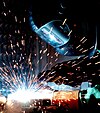Welding is a fabrication process that joins materials, usually metals or thermoplastics, by causing coalescence. This is often done by melting the workpieces and adding a filler material to form a pool of molten material that cools to become a strong joint, but sometimes pressure is used in conjunction with heat, or by itself, to produce the weld. Many different energy sources can be used for welding, including oxy-acetylene gas, an electric arc, a laser, an electron beam, friction, and ultrasound. While often an industrial process, welding can be done in many different environments, including open air, underwater and in space. Until the end of the 19th century, the only welding process was forge welding, which blacksmiths had used for centuries to join metals by heating and pounding them. Arc welding and oxyfuel welding were among the first processes to develop during the 1800s. Welding technology advanced quickly during the early 20th century as World War I and World War II drove the demand for reliable and inexpensive joining methods. Following the wars, several modern welding techniques were developed, including shielded metal arc welding, gas metal arc welding, submerged arc welding and flux-cored arc welding. Today, the science continues to advance, with robot welding becoming more commonplace in industrial settings, and researchers continuing to develop new welding methods.
Recently featured: Dawson's Creek – Use of poison gas in World War I – The Temptations
